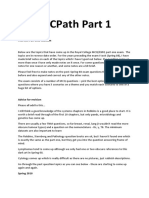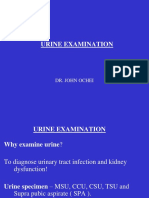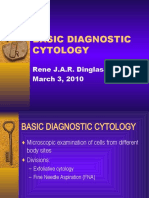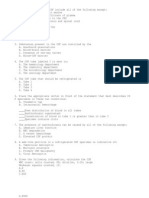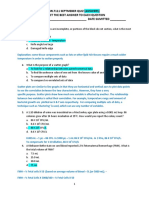Cell Types: Superficial Cells
Cell Types: Superficial Cells
Uploaded by
თამარ ჩალაურიCopyright:
Available Formats
Cell Types: Superficial Cells
Cell Types: Superficial Cells
Uploaded by
თამარ ჩალაურიOriginal Title
Copyright
Available Formats
Share this document
Did you find this document useful?
Is this content inappropriate?
Copyright:
Available Formats
Cell Types: Superficial Cells
Cell Types: Superficial Cells
Uploaded by
თამარ ჩალაურიCopyright:
Available Formats
Prepared by Kurt Schaberg
Cervical Cytology
Cell types Superficial Cells:
Small, pyknotic nucleus
Abundant cytoplasm (Often pink, can be blue)
Polygonal shape
Indicate abundant Estrogen
Intermediate Cells:
Abundant blue cytoplasm, polygonal shape
Larger, round to oval nuclei
Finer, normochromatic nuclei
→ Nuclei are important reference size
Basal/Parabasal Cell:
Minimal cytoplasm
Round to oval nuclei
Fine, but slightly dark chromatin
Usually few in number, unless atrophic
Endocervical Cells:
Uniform, Columnar cells
Polar, with round nucleus at one end
Majority of cytoplasm occupied by mucin
Arranged in flat sheets→ think “Honeycomb
Arranged in linear strips→ “Palisaded”
Endometrial Cells:
Small, High N:C ratio cells (almost all nucleus!)
Nucleus about the same size as an intermediate cell nucleus
Round nuclei with smooth chromatin, possible micronucleoli
Can be in large groups with outside epithelium and in inside stroma
Normal finding in first half of menstrual cycle if premenopausal
(Report if >50 yrs old)
Pap Smear Adequacy Criteria
(In practice, the number of cells is
Minimum number of well-visualized squamous cells for adequacy estimated based on sample photos,
Liquid-based preparation: 5,000 cells (ThinPrep and SurePath) and the cells aren’t counted).
Conventional Preparation: 8,000 to 12,000 cells
If obscuring elements cover >75% of epithelial cells → Unsatisfactory
Quality indicator: Presence of ≥10 endocervical cells or squamous metaplastic cells (reported, but not
required to be satisfactory for evaluation)
Any specimen with abnormal cells is considered adequate and should be reported!
Low-Grade Squamous Intraepithelial Lesion (LSIL)
Mature Keratinocytes (with lots of cytoplasm) AND:
• Enlarged nuclei (>3x normal intermediate cells)
• Nuclear membrane irregularities
• Hyperchromasia (“Rasinoid”)
• NO nucleoli
Optional:
• Perinuclear Halos = Koilocytes
• Large, irregular clearing
• Thick borders, like it was drawn with a
calligraphy pen
• Multinucleation
Caused by High and Low-risk HPV
May regress spontaneously!
Some findings, but “not enough”?
Consider “Atypical Squamous Cells of Undetermined
Significance” (ASCUS)
Can be either Quantitative (i.e., only rare atypical cells)
or Qualitative (e.g., only 2x nuclear enlargement)
High-Grade Squamous Intraepithelial Lesion (HSIL)
Immature keratinocytes (minimal cytoplasm, High N/C ratios) with:
• Markedly irregular nuclear contours
• (Hint: think in 3-dimensions)
• Look like boulders with all the irregularities
• Irregular chromatin and/or Hyperchromasia
Some findings, but “not enough”?
Consider “Atypical Squamous Cells—Cannot exclude HSIL” (ASC-H)
Can be either Quantitative (i.e., only rare atypical cells) or
Qualitative (e.g., only moderate atypia)
Squamous Cell Carcinoma
Non-keratinizing SCC may look like HSIL (similar findings)
Clues to invasion: “Tumor diathesis” (Necrotic debris)
Prominent nucleoli
Keratinizing SCC: Pleomorphic cells with hyperchromatic, irregular nuclei,
prominent orangeophilic (keratinizing) cytoplasm, and bizarre shapes (like
“Tadpoles” or snakes)
Tadpole Cell
Glandular Abnormalities
Reactive Endocervical Cells
Nuclear enlargement (4-5x),
Hyperchromasia, BUT round nuclei with smooth contours and
N:C ratios maintained. Prominent nucleoli.
Not too crowded. Mitoses, but no apoptosis.
Can see tubal metaplasia→ look for cilia!
For AIS, think “Feathery,”
like a bird’s wing.
Endocervical Adenocarcinoma In Situ (AIS):
Nuclei enlargement and crowding (cigar-like, think GI adenoma)
High N:C ratios with coarse, dark chromatin.
Cellular crowding with rosettes and “feathery edges”
Mitoses and apoptosis. No nucleoli.
Most strongly associated with HPV18 subtype
Adenocarcinoma
Variable, depending on site of origin/type.
Generally, more pleomorphic/irregular.
Endometrial cell nuclei larger than intermediate cell.
Features suggesting invasion: 1)Macronucleoli, 2)Tumor
diathesis, 3)increased single cells, and 4)irregular chromatin
Factors favoring endometrial adenocarcinoma (vs endocervix):
Neutrophils, less cytoplasm, smaller nuclei
Practically speaking, often diagnose as simply: “Atypical
Glandular Cells” using Bethesda System unless very
pleomorphic
Squamous metaplasia
Thick, “Dense” cytoplasm (consistent, dark teal)
Sharply defined cell borders.
Round, usually central nuclei
Normal nuclear size
Count as sampling of transition zone
Reparative/Inflammatory Changes
Classic “Repair”
Enlarged nuclei with Prominent Nucleoli.
Round nuclear contours with fine, pale chromatin.
Normal N:C ratios, but variably sized
Cohesive flat sheets of cells with “streaming” like pulled taffy
Background inflammation
General inflammatory change
Mild nuclear enlargement (<2x size)
Fine, pale chromatin
Often nucleoli
Can see small perinuclear clearing, but smaller, and more
even than koilocytic halos
Atrophy
Seen in LOW estrogen states:
Postmenopausal
Postpartum
Premenarche
Turner syndrome
Predominance of basal and parabasal cells (High N:C ratios)
Prone to injury→ often inflammation
Immature cells that can mimic HSIL, BUT:
Finely granular chromatin
Smooth nuclear contours
Can see “Blue blobs” (see →) and granular debris (mimicking
tumor diathesis, but no karyorrhectic nuclear debris)
Radiation Changes
Cytomegaly: Big cells with Big
nuclei (proportion N:C
maintained)
Large, bizarre cells
Cytoplasmic vacuolation and
polychromasia
Multinucleation
Follicular Cervicitis
Abundant lymphocytes (small rim of cytoplasm
around round nucleus, unlike HSIL, which is irregular)
Numerous tingible body macrophages
Variably sized lymphocytes with plasma cells.
IUD-Effect
Two characteristic findings:
1) Cells with abundant vacuolated cytoplasm
(mimicking Adenocarcinoma)
2) Cells with small, dark nuclei and scant
cytoplasm (mimicking HSIL)
Always know history! 1 2
Herpes
3 M’s
Molding of nuclei
Multinucleation
Margination of chromatin
“Ground glass” chromatin with eosinophilic nuclear inclusions
Can treat with acyclovir
“Shift” in flora
“Clue Cells” = squamous cells covered with shaggy bacilli and mixed
bacteria rather than the normal lactobacilli
Thick, milky vaginal discharge with a foul “fishy” odor
(positive “whiff” test after adding KOH)
Most commonly attributed to Gardenerella vaginalis.
Treat if symptomatic.
Trichomonas Vaginalis
Pear-shaped protozoan STD
Pale, eccentric elongate nucleus
Red cytoplasmic granules
Often associated with Leptothrix (non-pathogenic
filamentous bacterium).
Often acute inflammation and inflammatory halos
Treat with antibiotics
Candida
Fungal species that can cause infectious
throughout the GYN tract (and other areas).
Thick, “cottage cheese” discharge
Eosinophilic yeast forms and pseudohyphae and
hyphae (“Spaghetti and meatballs”)
Often tangled or skewering squamous cells
Can have variable associated inflammation or
inflammatory halos
Usually only treat if symptomatic
Actinomyces
Gram-positive anaerobic bacteria
Commonly associated with IUD (or other foreign body)
Long, filamentous organisms
Tangled clumps of bacteria that look like “cotton balls”
or “dust bunnies”
No need to remove IUD or treat if asymptomatic
General Management
This is a very generalized and abbreviated (but hopefully still helpful) summarization!
For a full review of current management guidelines, please refer to the ASCCP website:
http://www.asccp.org/guidelines
Pap result → Next step
Unsatisfactory → Repeat Pap in 2-4 months
NILM, but HPV positive (> 30 yrs) → Repeat co-testing at 1 yr, OR, HPV subtyping, if high-risk→ colpo
ASCUS → HPV testing (“if you Ask Us, you should get an HPV test”), if positive → colpo; Neg→ routine
LSIL → Colposcopy, unless HPV negative, then can do repeat co-testing at 1 yr
21-24 yo with ASCUS or LSIL → follow-up in 12 months (likely to clear spontaneously)
ASC-H → Colposcopy
HSIL→ Colposcopy or LEEP
Atypical glandular cells → Colposcopy with endocervical sampling and endometrial sampling
Screening Recommendations (according to the USPSTF):
Women 21-65 Cytology alone every 3 years
OR Women 30-65 Co-testing (cytology + HPV testing) every 5 yrs
(Don’t do HPV testing if less than 30 as high rate of positivity, but also clearance)
(Don’t do any testing before age 21, after 65 if they have had good prior screening, or after a
hysterectomy for benign reasons)
Human Papilloma Virus (HPV)
Sexually Transmitted Disease.
Circular double stranded DNA virus
Infects transformation zone→ establishes itself and replicates in basal cells
Detected in the vast majority of cervical cancers.
Viral genes responsible for transforming host cells by integrating into the host DNA and disrupting tumor
suppressor genes.
E6→ inactivates p53 (blocks apoptosis)
E7→ inactivates Rb (gets rid of cell cycle arrest→ uncontrolled growth)
However, many infections are naturally cleared, so only a minority persist and lead to cancer.
HPV subtypes
High-risk (associated with cervical cancer and HSIL, but can also cause LSIL)
16, 18, 31, 33
Type 16 is most commonly detected in cervical cancers
Type 18 is associated with Endocervical Adenocarcinoma
Low-risk (Not associated with HSIL. Instead associated with LSIL/condylomas)
6, 11, 42, 43
You might also like
- MCQ On Gynecological CytologyDocument28 pagesMCQ On Gynecological CytologyVincent Muhayimana100% (4)
- Kami Export - AWUGA (1) (1) - 6004007 - kTadpJKYQDocument6 pagesKami Export - AWUGA (1) (1) - 6004007 - kTadpJKYQsjbm maverickNo ratings yet
- Histology & CytologyDocument192 pagesHistology & Cytologyjahansha kurram86% (7)
- Osmosis Jones Video Questions WSDocument2 pagesOsmosis Jones Video Questions WSsamba100% (1)
- Histology StainsDocument7 pagesHistology StainsFrozenMan100% (2)
- FRCpath Part 1Document86 pagesFRCpath Part 1Ali Lafta100% (2)
- HISTOPATHOLOGIC AND CYTOLOGIC TECHNIQUES LEC Module 2Document14 pagesHISTOPATHOLOGIC AND CYTOLOGIC TECHNIQUES LEC Module 2Clair Tugna100% (2)
- Gyne Book 20122Document194 pagesGyne Book 20122თამარ ჩალაურიNo ratings yet
- CytologyDocument44 pagesCytologyMunish Dogra100% (3)
- Hematoxylin Stain Its Importance in HistologyDocument35 pagesHematoxylin Stain Its Importance in HistologyMunish Dogra60% (5)
- Histopathology Practical BookDocument55 pagesHistopathology Practical BookSuban Gouse91% (11)
- Clinical Chemistry Case StudyDocument8 pagesClinical Chemistry Case StudyGlydenne Glaire Poncardas Gayam67% (3)
- Urine ExaminationDocument36 pagesUrine ExaminationPrahlad singh100% (3)
- Lesson 6.b Automation HistopathologyDocument43 pagesLesson 6.b Automation HistopathologyJanielle Medina Fajardo100% (1)
- HistopathDocument38 pagesHistopathDarla YsavelNo ratings yet
- Blood Bank 2Document21 pagesBlood Bank 2moonfire2009No ratings yet
- Severe Hyponatremia Is Often Drug Induced: 10-Year Results of A Prospective Pharmacovigilance ProgramDocument18 pagesSevere Hyponatremia Is Often Drug Induced: 10-Year Results of A Prospective Pharmacovigilance ProgramlNo ratings yet
- Basic Diagnostic CytologyDocument18 pagesBasic Diagnostic Cytologydirenjan100% (3)
- Quality Assurance IN Histopathology: QC Should Consider The Whole ProcessDocument38 pagesQuality Assurance IN Histopathology: QC Should Consider The Whole Processalrasheed2020100% (1)
- Chemical Pathology Stage A Examination Sample QuestionsDocument10 pagesChemical Pathology Stage A Examination Sample QuestionsHabib UllahNo ratings yet
- Lesson 25 PDFDocument7 pagesLesson 25 PDFSeby Sebastian100% (1)
- Automated Cell Counts HB Estimation MethodsDocument10 pagesAutomated Cell Counts HB Estimation Methodsjohn mwambuNo ratings yet
- Cytology I - Techniques and Application: Peter NG Cyto Lab Ic, MT, PYNEHDocument201 pagesCytology I - Techniques and Application: Peter NG Cyto Lab Ic, MT, PYNEHbusiness onlyyou100% (1)
- Histopathology Chapter 4Document108 pagesHistopathology Chapter 4Zelalem Dejazmach100% (1)
- An Introduction To Routine and Special StainingDocument13 pagesAn Introduction To Routine and Special StainingBadiu ElenaNo ratings yet
- Serous Fluid Powerpoint HandoutDocument3 pagesSerous Fluid Powerpoint HandoutAnonymous ceYk4p4No ratings yet
- MD Pathology PDFDocument10 pagesMD Pathology PDFCOSTANTINUSNo ratings yet
- Practical Class - Absolute Eosinophil CountDocument10 pagesPractical Class - Absolute Eosinophil CountZainMalik80% (5)
- 5.0 LeukopoiesisDocument37 pages5.0 LeukopoiesisJunior SataNo ratings yet
- Hematology Special StainDocument28 pagesHematology Special Stainandreea0dey100% (1)
- Fixatives Staining PDFDocument228 pagesFixatives Staining PDFAira Nicole Dela Cruz100% (2)
- Fluid Cytology BookDocument129 pagesFluid Cytology Bookpooo80100% (1)
- Lect 1 Introduction To Histo PathologyDocument14 pagesLect 1 Introduction To Histo PathologyAbdul Hafeez100% (2)
- Cross Match TechniqueDocument5 pagesCross Match TechniqueANDREW MWITI100% (3)
- Paps SmearDocument51 pagesPaps SmearCatherine Merilleno100% (1)
- Respiratory Cytology IDocument13 pagesRespiratory Cytology IKrishma GoundarNo ratings yet
- Automation in Hematology Lab PDFDocument8 pagesAutomation in Hematology Lab PDFArtNo ratings yet
- MLT 1040 Unit 3 QuestionsDocument13 pagesMLT 1040 Unit 3 Questionstomsim_alsoNo ratings yet
- Respiratory Cytology I PDFDocument13 pagesRespiratory Cytology I PDFafdsdgsd100% (1)
- Lesson 30 PDFDocument5 pagesLesson 30 PDFLaura B.100% (1)
- Fixation & FixativesDocument64 pagesFixation & FixativesMadhura Shekatkar100% (1)
- Automation in HematologyDocument75 pagesAutomation in HematologyDann Francis Sarnillo50% (2)
- ML7111 MCQs Answers Sep 2019Document10 pagesML7111 MCQs Answers Sep 2019Cleo Salvador100% (2)
- Introduction To Histopathology and CytologyDocument25 pagesIntroduction To Histopathology and CytologyVinayNo ratings yet
- Histopathology Chapter 2Document141 pagesHistopathology Chapter 2Zelalem Dejazmach100% (2)
- Connective Tissue StainsDocument49 pagesConnective Tissue StainsLloyd LinNo ratings yet
- Manual For The Laboratory Diagnosis of Malaria.Document126 pagesManual For The Laboratory Diagnosis of Malaria.Mustafa Khandgawi100% (2)
- Liquid-Based Cytology (LBC) Method For Gynecologic CytologyDocument79 pagesLiquid-Based Cytology (LBC) Method For Gynecologic CytologyIndonesian Journal of CancerNo ratings yet
- 3 Red Blood Cells MorphologyDocument61 pages3 Red Blood Cells MorphologyJefferson Soriano67% (3)
- Summary in Histopath (Stain)Document15 pagesSummary in Histopath (Stain)Bless MarieNo ratings yet
- Red Cell Suspension Preparation and Reverse Typing ProcedureDocument2 pagesRed Cell Suspension Preparation and Reverse Typing Procedurediversedct100% (5)
- Lesson-21 Exfoliative Cytology PDFDocument4 pagesLesson-21 Exfoliative Cytology PDFSasa AbassNo ratings yet
- CytologyDocument12 pagesCytologyEsther HutagalungNo ratings yet
- Ain Shams University - Clinical Pathology Ain ShamsDocument182 pagesAin Shams University - Clinical Pathology Ain ShamsRowaa SamehNo ratings yet
- Papanicolaou Staining Technique PDFDocument7 pagesPapanicolaou Staining Technique PDFKat JornadalNo ratings yet
- Hematology 2 Lecture Notes Platelet Qualitative DisordersDocument4 pagesHematology 2 Lecture Notes Platelet Qualitative DisorderscccomayogNo ratings yet
- Blood BankingDocument7 pagesBlood BankingRoiland Atienza BaybayonNo ratings yet
- 2 Medicine MCQs - HemaologyDocument6 pages2 Medicine MCQs - HemaologyLALITA100% (2)
- HematologyDocument34 pagesHematologyAnne Angue GonzalesNo ratings yet
- 2.preparation and Staining of Thick and Thin BloodDocument31 pages2.preparation and Staining of Thick and Thin Bloodbudi darmantaNo ratings yet
- Practical PathologyDocument94 pagesPractical Pathologyadi raghavNo ratings yet
- Cytology Book?: (Based On Bethesda Form)Document22 pagesCytology Book?: (Based On Bethesda Form)Khairatul AyyunNo ratings yet
- English File Beginner 3rd Student's BookDocument137 pagesEnglish File Beginner 3rd Student's Bookთამარ ჩალაურიNo ratings yet
- Stewart M. - Nuclear Export of MRNADocument9 pagesStewart M. - Nuclear Export of MRNAთამარ ჩალაურიNo ratings yet
- Lipidebis Qimia Da Bioqimia: Neli SidamonizeDocument160 pagesLipidebis Qimia Da Bioqimia: Neli Sidamonizeთამარ ჩალაურიNo ratings yet
- ნაჩმიასი 1-6Document185 pagesნაჩმიასი 1-6თამარ ჩალაურიNo ratings yet
- Oxford EAP Elementary A2-87-90Document4 pagesOxford EAP Elementary A2-87-90თამარ ჩალაურიNo ratings yet
- Body Systems Work Together Reading PDFDocument2 pagesBody Systems Work Together Reading PDFYannahangela AbucayNo ratings yet
- Handouts - Normal Ob - Mr. Archie AlvizDocument1 pageHandouts - Normal Ob - Mr. Archie Alvizcianm1143No ratings yet
- An Intergenerational Approach To Break The Cycle of MalnutritionDocument9 pagesAn Intergenerational Approach To Break The Cycle of MalnutritionAdriana BahnaNo ratings yet
- Sesi 15-Making Your Hospital Baby FriendlyDocument47 pagesSesi 15-Making Your Hospital Baby FriendlySiti HajarNo ratings yet
- Dr. Jain T. Kallarakkal MD FCCP FRCP DM ST Mary's Hospital, ThodupuzhaDocument54 pagesDr. Jain T. Kallarakkal MD FCCP FRCP DM ST Mary's Hospital, ThodupuzhaTheo TNo ratings yet
- Vertigo and DizzinessDocument50 pagesVertigo and DizzinessAshraf HusseinNo ratings yet
- Case Studies: Restrictive and Obstructive Respiratory Conditions Case Study # 1Document5 pagesCase Studies: Restrictive and Obstructive Respiratory Conditions Case Study # 1psyarjavierNo ratings yet
- Care Plan PresentationDocument15 pagesCare Plan Presentationapi-307590979No ratings yet
- Vitamin E & K-BdsDocument50 pagesVitamin E & K-BdsIsaiah JohnsonNo ratings yet
- Practice Nurse Handbook Fifth Edition Gillian Hampson(Auth.) All Chapters Instant DownloadDocument40 pagesPractice Nurse Handbook Fifth Edition Gillian Hampson(Auth.) All Chapters Instant Downloadkelinthummvz100% (2)
- PCNL EhDocument38 pagesPCNL EhIndra JayaNo ratings yet
- Breastfeeding Frequently Asked QuestionsDocument12 pagesBreastfeeding Frequently Asked QuestionsGemmith GosanesNo ratings yet
- Faktor-Faktor Yang Mempengaruhi Tuberculosis Multidrug Resistance (TB MDR)Document9 pagesFaktor-Faktor Yang Mempengaruhi Tuberculosis Multidrug Resistance (TB MDR)Dian RohmayantiNo ratings yet
- Pe1 - Week 3Document23 pagesPe1 - Week 3Norman NarbonitaNo ratings yet
- EpisiotomyDocument30 pagesEpisiotomymob3100% (2)
- Medical and Surgical Nursing: Lecturer: Mark Fredderick R. Abejo RN, MANDocument9 pagesMedical and Surgical Nursing: Lecturer: Mark Fredderick R. Abejo RN, MANPRINCESS JOVELYN GUTIERREZNo ratings yet
- 2012 Theisen LL Et Al.Document1 page2012 Theisen LL Et Al.vishdubey777No ratings yet
- Hypertension: The Silent Killer: Updated JNC-8 Guideline RecommendationsDocument4 pagesHypertension: The Silent Killer: Updated JNC-8 Guideline Recommendationsek926922No ratings yet
- Editorial: Standardization of APTT Reagents For Heparin Therapy Monitoring: Urgent or Fading Priority?Document3 pagesEditorial: Standardization of APTT Reagents For Heparin Therapy Monitoring: Urgent or Fading Priority?Wiwing SetionoNo ratings yet
- Reproductive Physiology (Female)Document23 pagesReproductive Physiology (Female)هدى قحطان جليل100% (1)
- 14 Somatoform DisordersDocument13 pages14 Somatoform DisordersEsraRamosNo ratings yet
- Name of The Drug Mechani SM of Action Dosage Indicatio NS Contraindica Tions Adverse Reaction Nursing ResponsibilitiesDocument2 pagesName of The Drug Mechani SM of Action Dosage Indicatio NS Contraindica Tions Adverse Reaction Nursing Responsibilitieshey aadarshaNo ratings yet
- 7.18 - Sleep - Lecture NotesDocument10 pages7.18 - Sleep - Lecture NotesDan WuiytNo ratings yet
- Decision Tree: Nclex TrapsDocument3 pagesDecision Tree: Nclex TrapsAmeer Youseff Maroto100% (2)
- The Forehead Flap For Nasal ReconstructionDocument6 pagesThe Forehead Flap For Nasal Reconstructionsolikin ikinNo ratings yet
- Curriculum Vitae - DR ItaDocument2 pagesCurriculum Vitae - DR ItaZoel NikonianNo ratings yet





